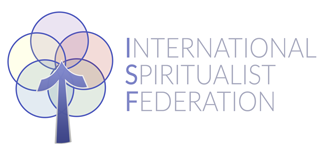A Brief History
The basic principles of International Spiritualism are clearly defined in the Constitution of the I.S.F. as follows:
“Spiritualism is founded on the facts of (a) personal survival of bodily death, and (b) communion between this world and the Spirit world.”
The universal relevance of these principles can be clearly seen from the fact that no race of people in any part of the world has ever been found, who did not as a general religious principle, accept that life continues beyond physical death. The possibility of Spirit communication has also been generally accepted. Christianity in particular, has canonised and venerated many people after establishing that Spirit communication with, or through them, had taken place.
Millions who fully accept Spirit communication have never associated themselves with Spiritualist societies, organisations or churches. Consequently, no reliable statistics have ever been produced and it is therefore impossible to estimate the total number of people who would readily accept these principles without realising they would thus qualify as Spiritualists. No doubt the figures could run into hundreds of millions.
Modern Spiritualism started in the nineteenth century as did many of the Societies, Organisations and Churches now members of the present International Spiritualist Federation. Congresses have been a feature of I.S.F. work since the beginning and have announced to the world that Spiritualism exists, demonstrating to delegates and visitors the wide and varied aspects of its phenomena and philosophy.
Early World Spiritualist Conferences were held, including Barcelona (1888), Paris (1889) and Liverpool (1901). Several attempts to form an international federation were made and had almost succeeded when they were interrupted by the 1914-1918 war. The war led to the rapid development of Spiritualism in many parts of the world and this in turn provided further incentive to concentrate our forces under a single banner, which was finally successful in 1923 at Liege, Belgium. Subsequent Congresses were held in Paris, London, The Hague, Barcelona and Glasgow until the second world war stopped all international work. Nevertheless in most individual countries the work of Spiritualism continued.
It was not until 1947 that a new start was made and in July of that year a special conference was held in Bournemouth, England, when a small number of delegates from Great Britain, France, South Africa, Canada and Sweden attended at the invitation of the Spiritualists, National Union of Great Britain. The outlook was far from bright. All the records of the original organisation had been lost from the Paris headquarters of the I.S.F. due to war activity, and a complete re-organisation was necessary. The enthusiasm for international unity was demonstrated by the fact that no fewer than 42 nations were represented at the first post-war Congress, held in London the following year.
It was on this splendid note of fellowship and accord that the I.S.F. resumed once more the great task of establishing a World Spiritualism able to help and inspire mankind across all races and outlooks. Congresses have been held in many countries since 1948 including, Sweden, France, Denmark, Scotland, England, Holland, Spain, and the United States. There are both individual and group members of the Federation in some 35 countries and membership is growing all the time.
There is every likelihood that the I.S.F. will surpass the wonderful achievements of its founders in the coming years, provided we unite in harmony to reflect and further the widening of interest in and understanding of Spiritualism.
The records of The International Spiritualist Federation are packed with the names of those who have served our great cause. From the earliest beginnings we have always had those who devoted their lives to making this world a better place in which to live.
History of The ISF Logo
Have you ever wondered how our emblem came about? Who designed it, where and when and what the symbolism is behind it?
Well for those of you who don’t already know it was designed by our very own honorary vice president Kay Rumen’s and our president in spirit Eileen Roberts.
At the ISFs 1981 Congress the decision was made to adopt a new symbol that would epitomise the aspirations of the ISF. Although it had been agreed upon to find a new logo very little occurred until two years later.
One Fraternal week in 1983 Kay and Eileen were sat in the halls at the Arthur Findlay College in Stansted, England listening to a
lecture when both began to sketch. They both realised that they were trying to create a new ISF logo and set about to create a simple design that would truly represent the ISF. Their conversation came round to the rings of the Olympics and how it was nice that they represented the five continents but that they seemed to be in competition with each other rather than in unison. It was this that led them to use the five rings but to place them in a position where they were blended together working in harmony.
The rings were also to represent the five elements of Earth, Air Fire, Water and Spirit. The colour blue was chosen for the background for the sky and all beyond the material world. The silver is to represent Mercury, the winged messenger, winging his message across the globe.
The arrow is a spear head, the spearhead touches upon all of the rings therefore all of the continents with the ISFs object of spearheading the interchange of Spiritual Knowledge and understanding around the world.
If the result reminds you of a flower, may it blossom forth and bear fruit in all lands. This image of the ISF logo as a flower, blooming , inspired us to bring our logo to its new, modern style.

